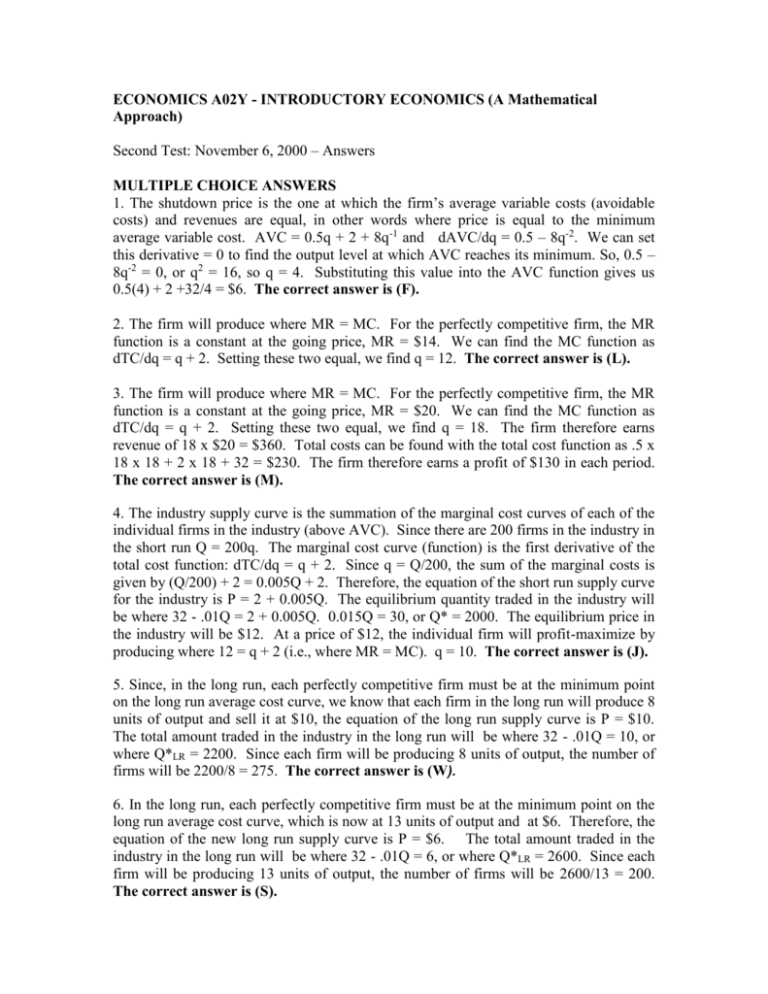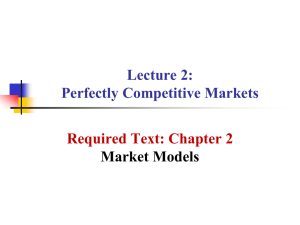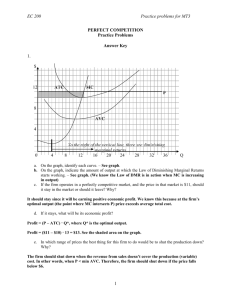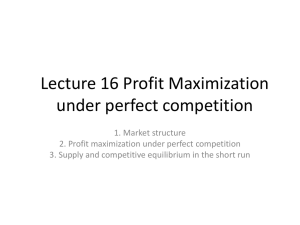Test answers
advertisement

ECONOMICS A02Y - INTRODUCTORY ECONOMICS (A Mathematical Approach) Second Test: November 6, 2000 – Answers MULTIPLE CHOICE ANSWERS 1. The shutdown price is the one at which the firm’s average variable costs (avoidable costs) and revenues are equal, in other words where price is equal to the minimum average variable cost. AVC = 0.5q + 2 + 8q-1 and dAVC/dq = 0.5 – 8q-2. We can set this derivative = 0 to find the output level at which AVC reaches its minimum. So, 0.5 – 8q-2 = 0, or q2 = 16, so q = 4. Substituting this value into the AVC function gives us 0.5(4) + 2 +32/4 = $6. The correct answer is (F). 2. The firm will produce where MR = MC. For the perfectly competitive firm, the MR function is a constant at the going price, MR = $14. We can find the MC function as dTC/dq = q + 2. Setting these two equal, we find q = 12. The correct answer is (L). 3. The firm will produce where MR = MC. For the perfectly competitive firm, the MR function is a constant at the going price, MR = $20. We can find the MC function as dTC/dq = q + 2. Setting these two equal, we find q = 18. The firm therefore earns revenue of 18 x $20 = $360. Total costs can be found with the total cost function as .5 x 18 x 18 + 2 x 18 + 32 = $230. The firm therefore earns a profit of $130 in each period. The correct answer is (M). 4. The industry supply curve is the summation of the marginal cost curves of each of the individual firms in the industry (above AVC). Since there are 200 firms in the industry in the short run Q = 200q. The marginal cost curve (function) is the first derivative of the total cost function: dTC/dq = q + 2. Since q = Q/200, the sum of the marginal costs is given by (Q/200) + 2 = 0.005Q + 2. Therefore, the equation of the short run supply curve for the industry is P = 2 + 0.005Q. The equilibrium quantity traded in the industry will be where 32 - .01Q = 2 + 0.005Q. 0.015Q = 30, or Q* = 2000. The equilibrium price in the industry will be $12. At a price of $12, the individual firm will profit-maximize by producing where 12 = q + 2 (i.e., where MR = MC). q = 10. The correct answer is (J). 5. Since, in the long run, each perfectly competitive firm must be at the minimum point on the long run average cost curve, we know that each firm in the long run will produce 8 units of output and sell it at $10, the equation of the long run supply curve is P = $10. The total amount traded in the industry in the long run will be where 32 - .01Q = 10, or where Q*LR = 2200. Since each firm will be producing 8 units of output, the number of firms will be 2200/8 = 275. The correct answer is (W). 6. In the long run, each perfectly competitive firm must be at the minimum point on the long run average cost curve, which is now at 13 units of output and at $6. Therefore, the equation of the new long run supply curve is P = $6. The total amount traded in the industry in the long run will be where 32 - .01Q = 6, or where Q*LR = 2600. Since each firm will be producing 13 units of output, the number of firms will be 2600/13 = 200. The correct answer is (S). 7. Since MR = MC, this firm is maximizing profit in the short run. It is not covering its average costs (P < AC), but it is covering its average variable costs (P > AVC). So, the best it can do in the short run is to keep output constant, and not shut down. The correct answer is (C). 8. The optimal hiring rule is that the firm should continue to hire workers until the marginal contribution of the firm to the revenues of the firm (the value of the marginal product) is just equal to the marginal cost to the firm of hiring more labour (the wage of the worker). In symbols VMPL = PL or MPL x PX = PL. Since, the marginal product of labour is dQ/dL = 48 – 0.2L, we can calculate (48 – 0.2L) x 10 = 20, or 480 – 2L = 20 or L = 230. The correct answer is (B). 9. The correct answer is (C). 10. Average variable costs are total variable costs/q and average fixed costs are TFC/q and average costs are AVC + AFC. Doubling of wages will double total variable costs at any level of q, so AVC will double. However, fixed costs are unaffected by a doubling of wages, so AFC is not changed. Since AVC doubles but AFC is unchanged, AC will less than double. Answer (H) is the correct answer. 11. This is a perfectly competitive firm which is maximizing its profit since MR = MC. The current price is above both average variable cost and average cost. Since both AVC and AC reach their minimums as they cross the MC curve, and since the current level of output must be greater than the outputs at which those minimums are reached, both AC and AVC must be rising at the current level of output. If output increases by a little bit, then AVC and AC will both still be rising. Average fixed cost is always falling as output increases. Marginal cost will be rising as output increases. Therefore, (G) is the correct answer. 12. The intercept of the short run industry supply curve is at P = 200. Another point on the supply curve comes at P = 600, Q = 400. The slope is the rise/run, so this is (600 – 200)/400 = 1. So the equation of the short run supply curve for the industry is P = 200 + 1Q or P = 200 + Q. This industry supply curve is the sum of the marginal cost curves of the 200 firms in the industry, so Q = 200q. We can substitute this into the industry supply curve to get the marginal cost curve of each firm. P = 200 + 200q. The correct answer is (E). 13. Since the firms and the industry are in a short run equilibrium position, and there are 200 identical firms in the industry, we can find this by simply dividing the industry output by the number of firms: 400/200 = 2. Alternatively, we could take the equilibrium price of the output, which is $600 and set it equal to the marginal cost function: 600 = 200 + 200q, so that q = 2. The correct answer is (B). 14. In the long run, each perfectly competitive firm must be at the minimum point on the long run average cost curve, with costs of $400 per unit of output . Since every firm operates at this output and these costs, and in the long run firms will enter the industry until the price is driven down to just equal average costs, and because this is a constant cost industry, we can deduce that the equation of the long run industry supply curve is P = $400. The demand curve has a vertical intercept of 1000 and a negative slope of 1000/1000 = 1, so the equation of the demand curve is P = 1000 – Q. Putting demand and supply together, we have 1000 – Q = 400, so that Q = 600. This is the long run output of the industry. Answer (F) is correct. 15. In the long run, firms in a perfectly competitive industry will necessarily earn zero profit in the long run. This occurs because, in the long run, firms can and will enter or exit the industry as long as returns in this industry are above or below normal returns available in other industries. Firms stop entering and exiting when the economic profit is equal to zero (i.e., firms are earning a normal level of return). The correct answer is (Y).







